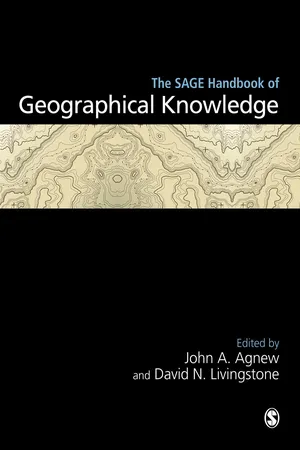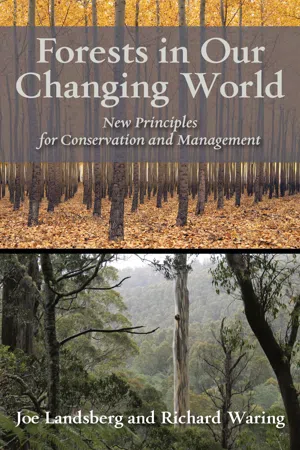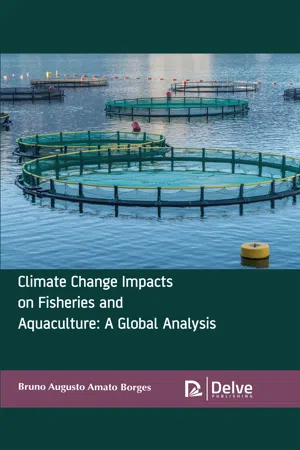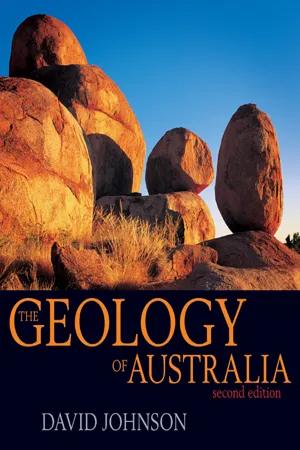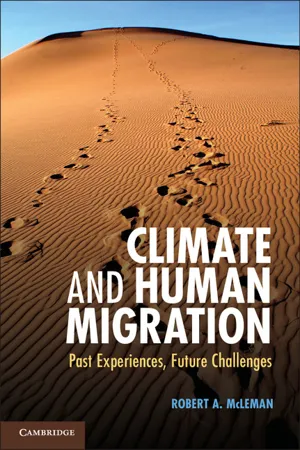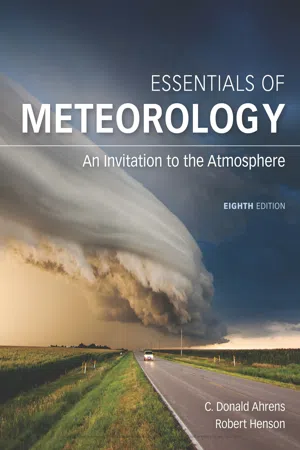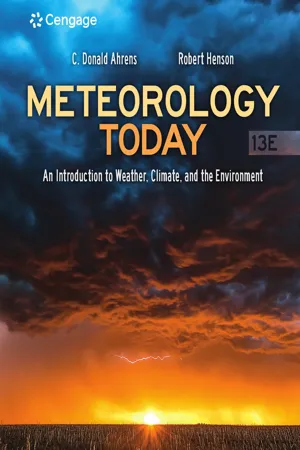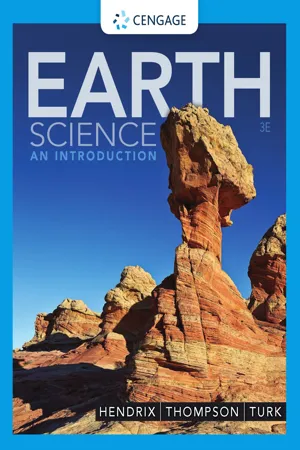Geography
Climate Change Causes
Climate change causes refer to the factors that contribute to the alteration of the Earth's climate patterns. These causes include human activities such as burning fossil fuels, deforestation, and industrial processes, which release greenhouse gases into the atmosphere. Natural factors like volcanic eruptions and solar radiation also play a role in driving climate change.
Written by Perlego with AI-assistance
Related key terms
1 of 5
11 Key excerpts on "Climate Change Causes"
- eBook - PDF
- John A Agnew, David N Livingstone, John A Agnew, David N Livingstone, SAGE Publications Ltd(Authors)
- 2011(Publication Date)
- SAGE Publications Ltd(Publisher)
40 Global Climate Change G l e n M . M a c D o n a l d INTRODUCTION The threat of global climate change due to increased anthropogenic emissions of green-house gasses has become one of the defining environmental issues of the twenty-first cen-tury. At the same time, the scientific com-munity, policy makers and the general public have become aware that even in the absence of anthropogenic factors the climate is prone to significant shifts due to natural causes. A tangible driver of this concern is the fact that global temperatures have increased by 0.76°C since the mid-nineteenth century and 11 of the 12 years between 1995 and 2005 were the warmest since 1850, the year when widespread reliable records become available (IPCC 2007). It is fair to say that humanity is feeling the heat of climate change. Few other issues present such a clear and pressing need to effectively integrate the physical, life and social sciences across geographic scales. The discourse on the causes, impacts and adapta-tions to changing climate should engage a broad spectrum of geographers. Academic geographers have long claimed as a core strength the ability to draw together the natu-ral and social sciences as they relate to the surface of the earth and human actions thereupon. The issues of climate change challenge geographers to live up to these claims. The following chapter will briefly outline the long history of scientific interest in climatic change and then discuss current understanding of some of the most important natural and anthropogenic causal factors that have been associated with recent climatic warming. Of particular interest here are the role of natural solar variability and the impor-tance of increasing levels of greenhouse gasses such as carbon dioxide (CO 2 ) methane (CH 4 ) and nitrous oxides (NO x ). Both these forces have been suggested to lie behind the recent rises in global temperature. The role of academic geography in global climate change research will be considered. - eBook - ePub
Forests in Our Changing World
New Principles for Conservation and Management
- Joe Landsberg, Richard Waring(Authors)
- 2014(Publication Date)
- Island Press(Publisher)
Chapter 4
Causes and Consequences of Rapid Climate Change
The earth’s climate has never been stable; geologic records show that, over millennia, the changes have been massive, ranging from ice ages to warm periods. But, within the last hundred years, as a result of human activities, air temperatures around the globe have been increasing at an unprecedented rate. This has serious implications and consequences, not just for forests but for all natural ecosystems and for human societies. Biological organisms and ecosystems have been able to change and adapt to the slow changes in earth’s climate that have occurred in past geologic ages, but they cannot change fast enough to adapt to the pace of the changes happening now.Rising global temperatures are triggering changes in the frequency and intensity of all sorts of other events, such as droughts, floods, hurricanes, the melting of glaciers and of the summer ice on the Arctic Ocean. It’s probably too late, now, to reverse the global warming process, although we must try to ameliorate it by reducing the activities that are causing climates to change. We must also, based on an understanding of the causes and effects, work to adapt the way our societies use the resources of the world and interact with natural systems. Forests are key factors in all this: they are affected by climate change and also help ameliorate it. Forests are heavily impacted by human demand for resources and therefore, as human populations grow, they come under more and more pressure. The whole question of climate change is therefore highly pertinent to this book.Causes of Global Warming
John Tyndall established, in Britain in the nineteenth century, that methane and carbon dioxide control the earth’s temperature by absorbing long-wave or infrared (heat) radiation . The atmosphere is transparent to short-wave solar radiation, which warms the earth but, as we noted in chapter 1 , much of the energy absorbed by the earth escapes as long-wave radiation. If it did not, the earth would get progressively hotter and life could not be sustained. But a proportion of the long-wave radiation is absorbed by carbon dioxide (CO2 ) and other “greenhouse gases” in the air, such as methane, nitrous oxide, and water vapor, and some of it is reradiated back to earth. This finely balanced “blanket,” or greenhouse effect , is extremely important for maintaining the stable temperatures suitable for life on earth. But if the concentrations of absorbing gases increase, the amount of long-wave radiation absorbed in the atmosphere and reradiated back to earth will increase, and temperatures at the ground and in the lower layers of the atmosphere will rise. This is called radiative forcing , because the mechanism of temperature change depends on changes in the radiation balance. In 1896 the Swedish chemist Svante Arrhenius provided an equation describing the radiative forcing effect of CO2 that is still used today.1 He was the first person to predict that emissions of CO2 from the burning of fossil fuels and other combustion processes could lead to global warming. A change in the earth’s energy balance of 0.3 percent, equivalent to a change in radiative forcing of 0.5 W m–2 - eBook - PDF
Climate Change Impacts on Fisheries and Aquaculture
A Global Analysis
- Bruno Augusto Amato Borges(Author)
- 2019(Publication Date)
- Delve Publishing(Publisher)
The role Climate Change: A Global Perspective 13 of volcanoes in climate change has been clearly seen. Volcanic particles suspended in the upper atmosphere have the capacity to reflect sunlight back to space. This has a cooling effect on Earth, by a few tenths of a degree, the effect of which can last for many years. In order to perceive a pronounced impact, it takes many eruptions. A single eruption produces only produces particles that last in atmosphere for a short period of time when compared to GHGs. Change in land use and land cover has also affected the planets’ ability to reflect. Human activities like deforestation, urbanization, desertification, and reforestation have contributed to climate change in the areas where they occur. These effects are not perceived much globally but are significant in the regions where they occur. Increase in human activities has raised the level of aerosol particles in the atmosphere. Human generated aerosols have been able to off-set 30% of the impact of the greenhouse emissions. Any reduction in the aerosol emission can cause the temperature to rise. Target actions for decreasing carbon emissions can reduce warming. 1.4. IMPACT OF CLIMATE CHANGE The global warming impacts the physical, biological, and human systems. In physical systems impact is visible on glaciers snow, waterbodies, and extreme natural phenomena. In biological system, it is causing death of flora and fauna, changes in ecosystems. In human system, Climate Change Causes destruction of crops, disease, and death, affects the economy and results in migration of climate refugees. Moreover, the negative effects also are interdependent. For example, drought can cause wildfires which cause destruction of vegetation. Similarly, sea level increases due to melting of glaciers. This in turn affects the marine ecosystem and also impairs economic activities. - eBook - PDF
- David Johnson(Author)
- 2009(Publication Date)
- Cambridge University Press(Publisher)
277 CHAPTER 13 A geological perspective on climate change The Earth has always experienced major fluctuations in climate. What is the scale of these fluctuations in temperature and in time? Do we know what caused these changes? What is driving the present changes in the Earth’s climate? GEOLOGICAL FACTORS INFLUENCING CLIMATE CHANGE Five main factors have influenced Earth’s climate in the geological past: changes in solar activity • variations in the Earth’s orbit • plate movements and mountain building • volcanic eruptions • greenhouse gas interactions. • An obvious trigger would be variations in the intensity of solar radiation. Perhaps it was less intense at various times, before returning to the more typical state. Alternatively, the Earth might have experienced major changes in its orbit, at times being much further from the Sun, 278 T H E G E O L O G Y O F A U S T R A L I A so that solar heating would be lessened. Volcanic eruptions can fill the atmosphere with dust and aerosols, screening out solar radiation. Mountain building can thrust landmasses upwards to intersect the colder air higher in the atmosphere. Greenhouse gases, especially water vapour, carbon dioxide and methane, retain heat in the atmosphere; higher concentrations of these gases match warmer periods, and lower concentrations the glacial episodes in Earth history. Changes in solar activit y Our current understanding of the Sun’s nuclear processes predicts the Sun’s output will gradually increase for the next 5 billion years, and that the Sun now is emitting some 25–30% greater radiation than it was when the Earth first formed 4.6 Ga ago. There is no theoretical basis for suggesting major fluctuations on the scale of millions of years; however such changes are not ruled out. Certainly solar irradiance varies with the Figure 13.1 Break-up of the Larsen B ice shelf over 35 days in early 2002 as revealed by satellite imagery from the NASA Moderate Resolution Imaging Spectroradiometer (MODIS). - eBook - PDF
- Singh, M P(Authors)
- 2021(Publication Date)
- Daya Publishing House(Publisher)
In fact, the changes are profound and mirror those in the human-nature relationship. They cascade through the Earth’s environment in unpredictable ways and call for societies to develop a range of creative response and adaptation strategies. If this does not happen, there is every possibility that the earth itself may be driven into a different state and one that would be less hospitable to humans and other forms of life. Global climate change is of interest because of the probability that it may affect the ease with which humans make a living, and perhaps, the carrying capacity of the planet for humans and other species. There exists the distinct possibility that human activities will cause global climate change because our choices can then affect outcomes. With global environmental change now occupying an increasingly central This ebook is exclusively for this university only. Cannot be resold/distributed. place in human affairs, a vigorous international debate has ensued about the nature and severity of global change and its implications for lifestyles. Science can help societies in developing and communicating the essential knowledge base that may be instrumental in deciding on how to respond to global change. The Earth behaves as a system in which the oceans, atmosphere and land, plus it living and non-living parts are all connected. As human activities are responsible for some parts of global change, successful attempts have been made to separate natural and anthropogenically induced variability in the Earth system. Global change is an outstanding environmental issue facing humankind today. Some major research findings in the last decade are outlined below (Steffen and Tyson, 2001). The Earth is a system that life itself helps to control. Biological processes interact strongly with physical and chemical processes to create the planetary environment. - eBook - PDF
Climate and Human Migration
Past Experiences, Future Challenges
- Robert A. McLeman(Author)
- 2013(Publication Date)
- Cambridge University Press(Publisher)
Because climate is in proportional terms so rare a proximate cause of migration, scholars who special- ize in migration research have largely tended to consider it in passing, if they consider it at all. Check any textbook used to teach undergraduate courses in migration over the past few decades, and you will find few mentions of climate. Since the 1980s, natural scientists have accumulated convincing evidence that human activity is causing unprecedented changes to the atmosphere, and that we have entered an era of rapid, human-induced climate change. Warnings that this will create hundreds of millions of environmental refugees in coming decades have led a small 1 An Introduction to the Study of Climate and Migration 2 An Introduction but growing number of scholars to reconsider the relationship between climate and migration. Their research is showing that climatic events and conditions will likely have a greater influence on migration in the future. However, that influence will most often be felt as part of a complex interplay with cultural, economic, political, and social factors that shape human migration behavior and patterns. Further, migration in the context of changing climatic events and conditions is not a discrete, stimulus- response phenomenon, but is typically one of a range of possible outcomes that may result as people adapt to changes occurring around them. The evidence that leads to this conclusion comes from careful examinations of past and present migration events, using a variety of theoretical, conceptual, and methodological approaches to tease out the contribution of climate and the nature of its interaction with other factors. These theories and concepts have been drawn from the natural and social sciences and employ a range of quantitative, qualitative, and geospatial imaging methods. - eBook - PDF
Essentials of Meteorology
An Invitation to the Atmosphere
- C. Donald Ahrens, Robert Henson(Authors)
- 2017(Publication Date)
- Cengage Learning EMEA(Publisher)
(It is important to note that modern-day volcanic activity emits less than 1 percent of the CO 2 pro- duced by human activity.) Mountains can cause the climate to change in a variety of ways. A chain of volcanic mountains forming perpendicular to the mean wind flow may disrupt the air- flow over mountains, altering the climate both upwind and downwind of them. By the same token, mountain building that occurs when two continental plates collide (like that which presumably formed the Himalayan mountains and Tibetan highlands) can have a marked influence on global circulation patterns and, hence, on the climate of an en- tire hemisphere. It has been theorized that the uplift of the Himalayas and Tibetan plateau helped to increase chemi- cal weathering, thus pulling more carbon dioxide out of the air and lowering global temperature—perhaps enough to help trigger the onset of the Ice Age. Up to now, we have examined how climatic varia- tions can take place over millions of years due to the movement of continents and the associated restructur- ing of landmasses. We will now turn our attention to variations in Earth’s orbit that may account for climatic fluctuations that take place on a time scale of tens of thousands of years. CLIMATE CHANGE: VARIATIONS IN THE EARTH’S ORBIT Another external cause of climate change involves a change in the amount of solar radiation that reaches Earth. A theory ascribing climatic changes to variations in Earth’s orbit is the Milankovitch theory, named for the astronomer Milutin Milankovitch, who first proposed the idea in the 1930s. The basic premise of this theory is that, as Earth travels through space, three separate cyclic movements combine to produce variations in the amount, location, and timing of solar energy that falls on Earth. The first cycle deals with changes in the shape (eccentricity) of Earth’s orbit as Earth revolves about the sun. - C. Donald Ahrens, Robert Henson(Authors)
- 2021(Publication Date)
- Cengage Learning EMEA(Publisher)
WEATHER WATCH Copyright 2022 Cengage Learning. All Rights Reserved. May not be copied, scanned, or duplicated, in whole or in part. Due to electronic rights, some third party content may be suppressed from the eBook and/or eChapter(s). Editorial review has deemed that any suppressed content does not materially affect the overall learning experience. Cengage Learning reserves the right to remove additional content at any time if subsequent rights restrictions require it. EARTH’S CHANGING CLIMATE 537 Climate Change and Extreme Events: What’s the Connection? Disasters such as hurricanes, tornadoes, wildfires, and floods often have people wondering whether climate change might be boosting the occurrence of such extremes. Someone concerned about climate change may point to a record-smashing high temperature in one city and note the role of increased greenhouse gases in fostering record heat, while someone who dismisses a human influence on climate may cite a massive snowfall (see ● Fig. 4) as evidence against global warming. No single weather event is “caused” by a changing climate, but research shows that human-produced greenhouse gases are making some types of extreme weather more likely. Temperatures are rising in most regions at most times of the year, which raises the odds of more intense and prolonged heat waves. Record daily high temperatures in the United States are now twice as common as record daily lows. Yet weather is still naturally variable, so the occurrence of unusual cold or heavy snow is in no way a rebuttal of human-caused climate change. There is ample evidence that precipitation is becoming increasingly concentrated in very heavy rain and snow events in many parts of the world. A warming climate allows more water to evaporate into the atmosphere from the oceans, which could help intensify rain and snow where it is falling. However, warmer temperatures also help draw moisture from already-dry land.- eBook - PDF
Earth Science
An Introduction
- Mark Hendrix, Graham Thompson, Mark Hendrix(Authors)
- 2020(Publication Date)
- Cengage Learning EMEA(Publisher)
Rich Carey/Shutterstock.com Copyright 2021 Cengage Learning. All Rights Reserved. May not be copied, scanned, or duplicated, in whole or in part. Due to electronic rights, some third party content may be suppressed from the eBook and/or eChapter(s). Editorial review has deemed that any suppressed content does not materially affect the overall learning experience. Cengage Learning reserves the right to remove additional content at any time if subsequent rights restrictions require it. 508 CHAPTER 21 Climate Change and Oceanographic Association (NOAA). It shows five feet (1.5 meters) of sea-level rise in the Boston region and includes a hypothetical view of Harvard’s Dunster House with this level of rise. EFFECTS ON PEOPLE Humans evolved during a peri- od of rapid climate change in the savannas and forests of Africa. In fact, many anthropologists argue that we flour- ished because we adapted to climate change faster and more efficiently than other species in the African ecosys- tem. A few million years later, we survived the Pleisto- cene Ice Age. We are a clever and resourceful species. Yet the consequences of global warming could be severe. In a warmer world, tropical diseases such as malaria have been spreading to higher latitudes. But the biggest problem arises because expanding human population is already stressing global systems. Because of high population den- sity, land ownership, and political boundaries, people can- not migrate as freely as they once could. As a result, small shifts in food production or water availability could lead to mass starvation, water scarcity, and political instability. In addition, rising sea level could flood coastal cities and farmlands, causing trillions of dollars worth of damage throughout the world. There is already great stress on our water supply, as you read about in Chapter 12. - eBook - PDF
- Peter E Hodgson(Author)
- 2010(Publication Date)
- ICP(Publisher)
We would do well to remember that our civilization depends on ade-quate supplies of energy and we are still at the mercy of earthquakes, tornadoes, tsunamis and volcanic eruptions. We still rely on nature to provide our food, and this in turn depends on the climate. If the climate changes, it may become more difficult to grow the crops we need, and our domestic animals may suffer. If the increasing demand for more energy is met by burning fossil fuels the resulting pollution will reduce the productivity of the land and the sea. At the same time the world population inexorably increases and the demand for a higher standard of living will be difficult if not impossible to meet. These problems are inextricably linked together. The rising popula-tion and its rising expectations require more energy. The production of this energy is made increasingly difficult as the reserves of possible fuels are exhausted. Energy production can cause global warming and climate change, and this reduces the capacity of the earth to grow the needed food. In the end, something has to give way. Will it be famine, or wars or pestilence, or a combination of the three? 7.3. The Reality of Climate Change It took a long time for the reality of climate change to be recognized, in particular the global rise in temperature at sea level. The story began with the pioneering work of the Swedish scientist Svente Arrhenius, who realized that industrial processes leading to the emission of carbon dioxide could warm the earth. This conclusion was supported by the independent research of Thomas Chamberlain. Their results attracted little attention because it seemed that human activities must be insignificant compared with many other effects on the climate such as the sunspot cycle and the changes of the earth’s orbit around the sun. Furthermore, there is about fifty times as much carbon dioxide in the 102 ✦ Energy, The Environment and Climate Change - eBook - PDF
- James Petersen, Dorothy Sack, Robert Gabler, , James Petersen, James Petersen, Dorothy Sack, Robert Gabler(Authors)
- 2021(Publication Date)
- Cengage Learning EMEA(Publisher)
Variations in solar output; 3. Changes in ocean circulation; 4. Changes in landmasses and ocean basins; ice sheets retreat and ocean areas covered with sea ice are reduced, low-albedo land and ocean surfaces will absorb more solar radiation. The result will be further warming and more ice melting, conditions that magnify rates of glacial retreat. This albedo-ice feedback interaction may have played a role in the cycles of glacial advance and retreat during the Pleistocene. 8-3 Natural Influences on Climate Change Ultimately, climate change occurs because of variations in three factors: the amount of solar energy entering the Earth system, the amount of energy the Earth system stores, and the amount of energy our planet loses to space. Theories about the causes of ● FIGURE 8.21 Pollen varies by species, and the mix of pollen types differs over time with climate-related environmental changes. Pollen species counts within sediment layers identify the types of vegetation that existed at the time of deposition. This is an electron microscope image that was colorized artificially, making it easy to see different species. The largest green-colored pollen grain from a morning glory flower is 100 micrometers in diameter (four one-thousands of an inch). How can plant experts (botanists) help paleoclimatologists reconstruct climates of the past? William Crochot/Dartmouth Electron Microscopy Facility ● FIGURE 8.23 Oxygen isotope ratios from ice cores were used to produce this graph of temperatures for the last 110,000 years. The record provides evidence of significant climate change over surprisingly short periods of time. 0 –10 Age (thousands of years) 100 80 60 40 20 10 0 Average temperature difference as compared with present (degrees Celsius) Wisconsinan glaciation Holocene Altithermal Pleistocene ● FIGURE 8.22 Paleoclimates can be reconstructed using O / O 18 16 ratios from ice cores taken in Greenland and Antarctica.
Index pages curate the most relevant extracts from our library of academic textbooks. They’ve been created using an in-house natural language model (NLM), each adding context and meaning to key research topics.
